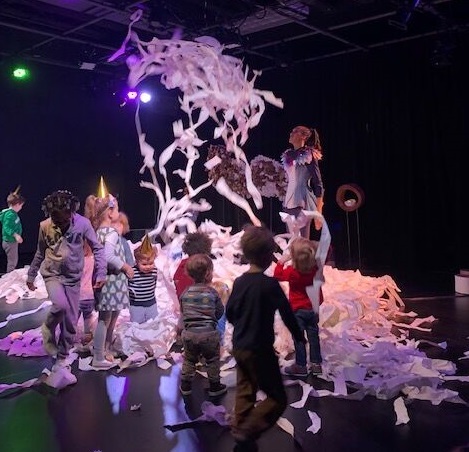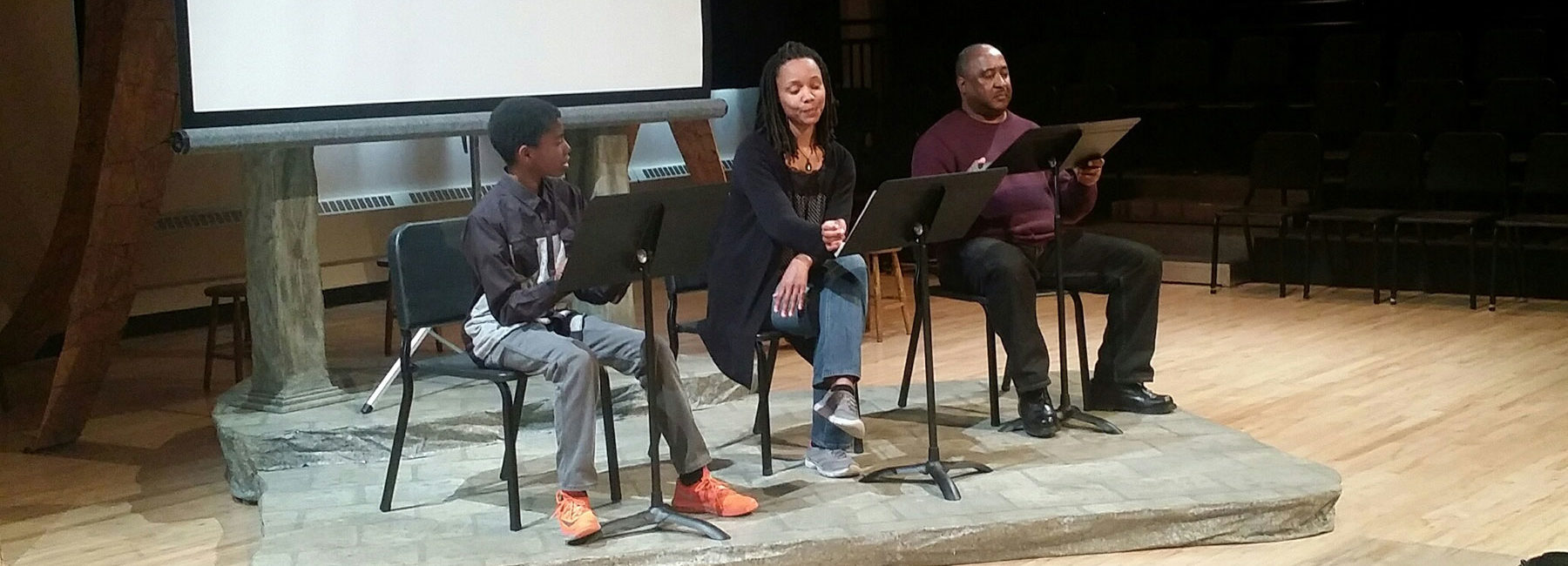Regional theatres, which primarily produce work for adults, emerged in the 1960s and 1970s as “an alternative to the theatre on Broadway,” a place where actors could work and audiences could see plays in their own communities, explains Joseph Wesley Zeigler in his book Regional Theatre: The Revolutionary Stage. Despite the focus on live theatre’s availability outside of New York, the plays that Zeigler mentions (including Shakespeare and Marlowe) have little to do with the communities where those plays were performed. While more patrons could access theatre in their home communities, the work they saw more closely resembled what they could have seen in New York than where they lived.
American TYA also began in a somewhat centralized place (most notably, Chicago, IL), and had a larger geographic footprint earlier than regional theatre. Unlike regional theatre, much of modern TYA stemmed from an early 1900s goal of encouraging young immigrants to assimilate into American culture. In this way, TYA was founded on the premise of educating children rather than broadening access to the performing arts from adult to young audiences, and the tension between these two goals (education versus providing artistic experiences) still echoes through the field today. TYA institutions, like regional theatres, have often produced stories relevant to audiences in theme but not necessarily in place (fairy tales, adaptations of popular children’s books, and more recently, abstract and devised pieces whose settings may be ambiguous or fantastical). All of these types of work offer value for audiences; building understanding and curiosity and empathy about characters whose experiences are different from our own is a key benefit of experiencing live theatre.
Even in a time when technology instantly connects us to many places around the world, there is still immense value in stories that reflect the places where patrons live. Plays set in the same place where a commissioning theatre is located can inspire audiences to reflect on and celebrate their homes, as well as challenge them to find ways to engage more deeply with their local culture and their neighbors. A number of regional theatres have begun to commission and produce works that are specifically linked to their geographic location, as have a growing number of TYA companies. These theatres are creating innovative place-specific work that intentionally considers the experiences of young people growing up around the United States, both throughout the development process of TYA pieces and in the content of the pieces themselves.
The Sky Game
Peppercorn Theatre at Kaleideum
Winston-Salem, NC
The Sky Game, written by Kimberly Belflower, was commissioned by Peppercorn Theatre at Kaleideum in Winston-Salem, NC and was performed at the Delta Arts Center in the summer of 2017. The story follows “a trio of misfit kids from a neighborhood in Winston-Salem that is undergoing a lot of change,” as Belflower puts it. The characters devise an intricate game in which they cast themselves as heroes fighting against the “garbage monsters.” These unseen antagonists serve as a metaphor for changes the pre-teen characters experience in their lives outside the game. A skyrocketing cost of living forces one of the characters to move at the end of the summer. As the trio grapples with this impending change, they meet a fourth character, a girl who moved to Winston-Salem and is from a different part of town, but attends a new school in the trio’s neighborhood. All of the young people unite to defend their favorite tree, which is destined to be cut down as the neighborhood changes around them. “In adult terms, it’s gentrification,” Belflower explains. “In kid terms, it’s the idea that what we know is constantly changing, which is also true of childhood.”
"What is our responsibility when this is our reality? Who gets to choose art first?”
— Harry Poster
Peppercorn’s former Artistic Director Harry Poster commissioned the piece, the theatre’s second in a series of projects that brought playwrights to Winston-Salem to experience the city and discover what inspired them about the area. “We want to give [the playwright] experience in our community before [they] write the play,” Poster noted, “so [they] can get to know the audience that [their] play will be produced for.” Belflower, with Hannah Wolf (who co-conceived and directed the piece), spent a week in Winston-Salem, a small city of a little under 250,000 residents, interviewing community members who worked with young people on a daily basis. She described one particularly important juxtaposition within these interviews that helped her hone in on gentrification as a focus for the piece. One morning, she met with a teacher from a charter school about his enthusiasm about Winston-Salem’s city slogan “Arts First” and the emphasis the city placed on prioritizing the arts. Later the same day, she talked with the director of an after-school arts program who brought to her attention that, while there is a focus on the arts in Winston-Salem, the city also ranks second in child hunger in the country. He asked her to consider, “What is our responsibility when this is our reality? Who gets to choose art first?” Having both of these conversations in the same day, Belflower explained, helped her hone in on highlighting a familiar duality: “a push and pull between progress and tradition, these two separate realities.” Originally from Georgia, Belflower noted that she recognized these contradictions in her conversations with the two arts educators as familiar elements of the American south.
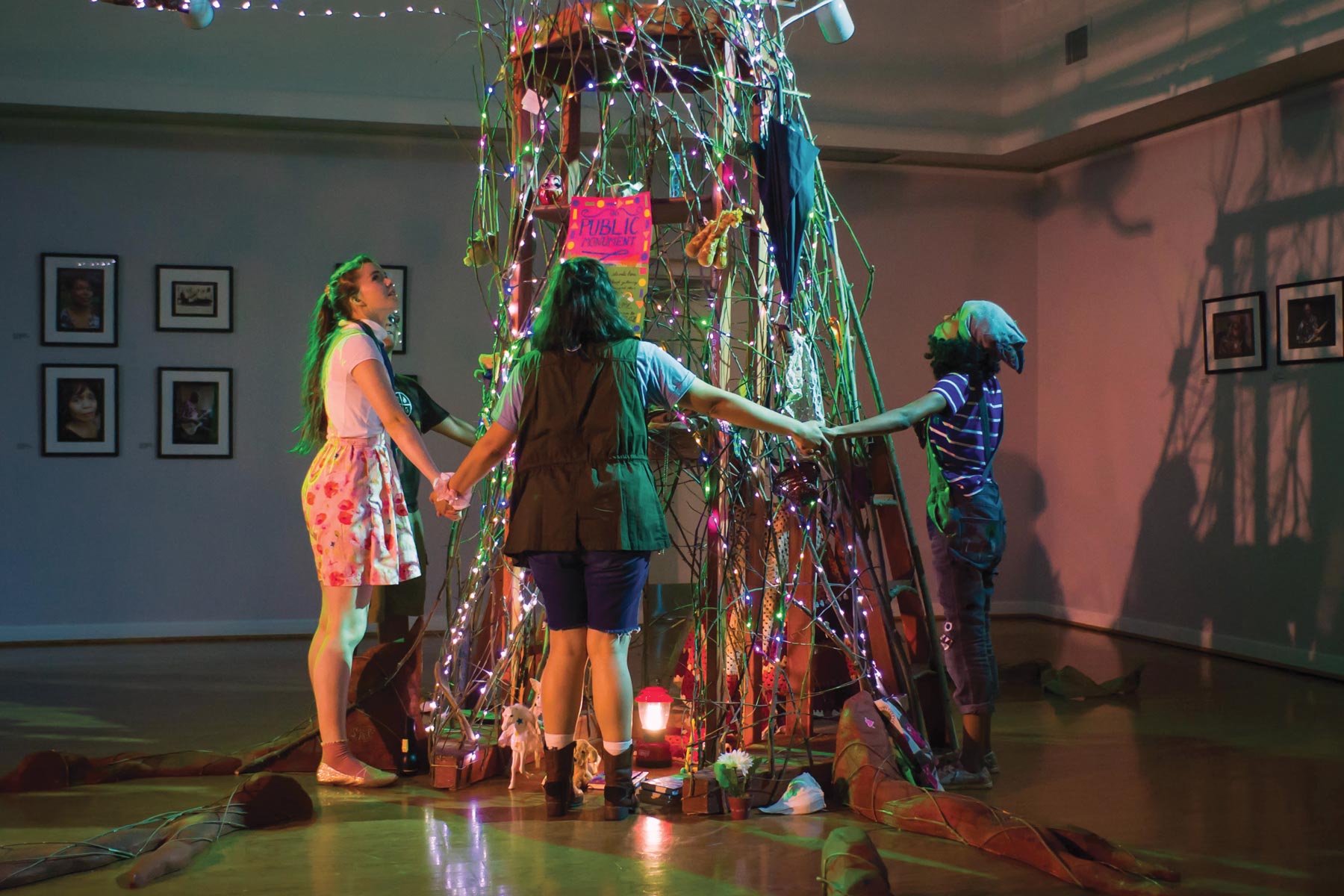
Ramon Perez, Katherine Olsen, Maria Ortiz-Marquez, and Simone Pommels in The Sky Game by Kimberly Belflower. Peppercorn Theatre at Kaleideum, Winston-Salem, NC. Photo by Hearts and Arrows Photography.
Later in the play’s development process, Dramaturg Claire Simpson worked with a group of seventh grade students through Peppercorn’s Young Dramaturgs program to explore similar tensions – ideas of place and community and gentrification – then to provide feedback on early drafts of The Sky Game. Students in the program reviewed individual scenes as they evolved, making notes about what elements of the play they connected with, what they liked about the characters, and what they thought needed to change. Simpson relayed these notes back to the Belflower, who incorporated the students’ ideas and sent them questions in return. Belflower noted the impact of the students’ work on the eventual script: “Kids are the best dramaturgs … They don’t hold out at all. They’ll say ‘that’s stupid.’ They gave me permission to go for things I was originally nervous about.” Peppercorn’s process included both adult and youth voices throughout the process, which helped to make the play relatable to all of its audience members, both the young people for whom the play was created and the adults that joined them at the theatre.
Stories specific to a place can spark recognition (“I know where they’re talking about!”), resonance, and excitement in audience members. But writing about place comes with great weight and responsibility, especially for artists who may not call that local community home. Writing about a specific place with the understanding that the play will be produced in that place may increase the sense of need to “get it right,” as Belflower expressed, and this pressure exists with good reason. Place is often an essential part of our identities, whether we consciously connect those two concepts or not. As Becca Drew Ramsey, director of theatre & creative learning at Peppercorn (who served The Sky Game in a teaching artist capacity) noted, “There’s a lot of responsibility for us to consider the way that we represent places because people are FROM them. The play is set in Winston-Salem, and the kids who come see it are reflecting on where they’re from because someone wrote a play about it. There’s a lot of power, but it’s also really complicated.”
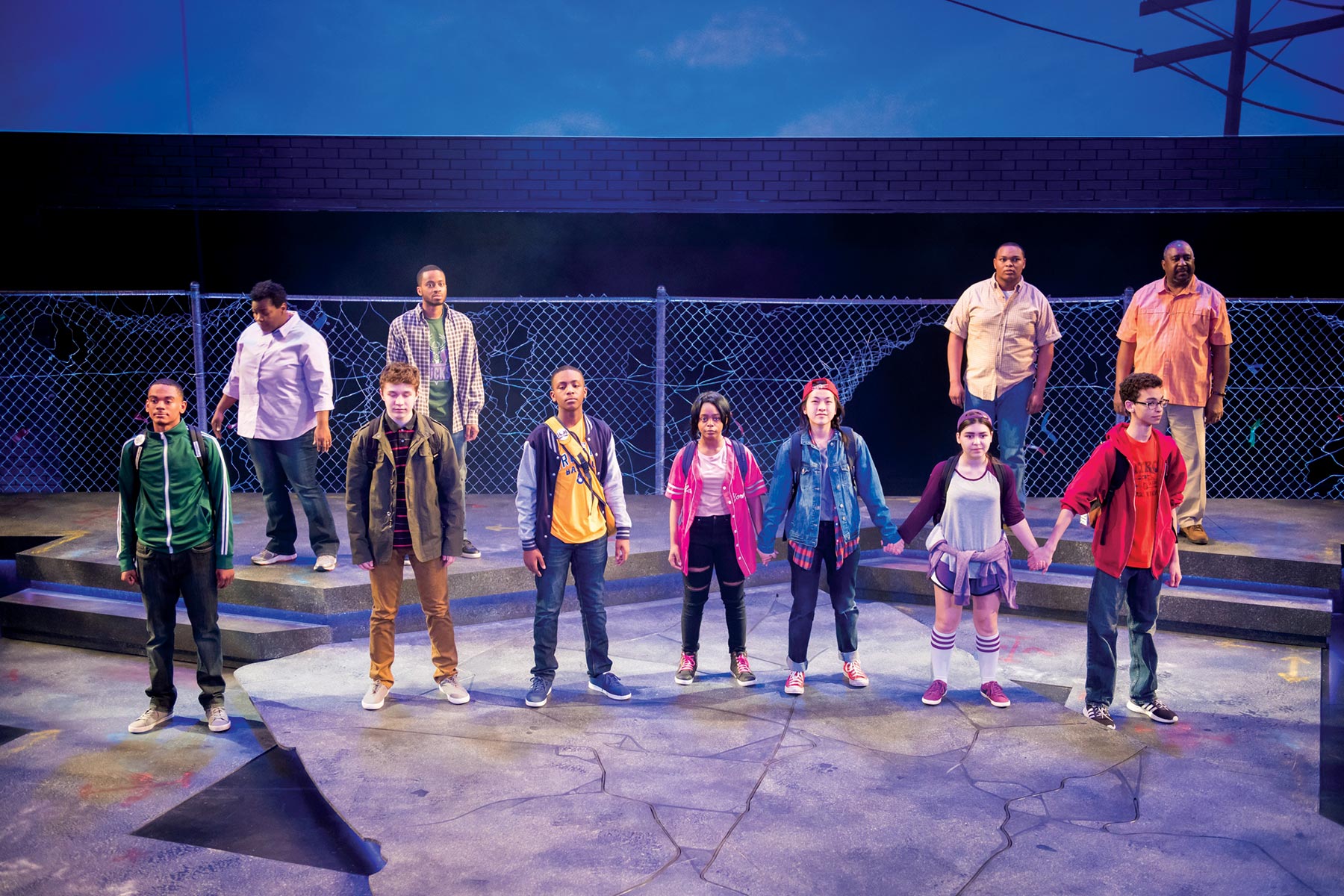
Tasha McCoy, Marques Causey, Justin Lee, Allen D. Edge and cast in ANTARCTICA WI by Finnegan Kruckmeyer. First Stage, Milwaukee, WI. Photo by Paul Ruffolo.
Antarctica, WI
First Stage
Milwaukee, WI
Antarctica, WI, written by Finegan Kruckemeyer, was co-commissioned by First Stage in Milwaukee, WI and Filament Theatre in Chicago, IL. The play was first produced in Milwaukee in April of 2018. Like The Sky Game, the piece is about a group of young people who are in transition, both within their own lives and in response to larger events in their community. Intended for middle and high school audiences, the script follows a group of teenagers whose summer is shaped by events both within their immediate community (baseball games and romantic interests and revealing parts of their evolving identities to their family members) and by events in their city more broadly (planned construction that will remove the lot that is their baseball field, the fear they experience when seeing a police car drive past them as young people of color). The play was inspired in part by the Sherman Park riots that took place in Milwaukee in the summer of 2016, sparked by a “rash of violence,” as the First Stage community engagement materials for the piece describe, as well as the fatal shooting of a young black man by a police officer. “We needed to give students context for meaningful experiences, a safe space to start a dialogue about our city,” explained First Stage’s Education Director Julia Magnasco. “To say that [the events that happened in Milwaukee two summers ago that influenced our community] weren’t affecting the young people would be a falsehood. They weren’t affected only by the events themselves but also by what led up to those events. [We were thinking about] what is our responsibility as a theatre? How can we help heal a hurting community?”
The play’s development process included the youth voices from the beginning, when Kruckemeyer interviewed young people from different parts of Milwaukee about what it means to grow up in the city. First Stage’s education department, with Magnasco at the helm, paid careful attention to the identities of these young people with whom Kruckemeyer spoke. They invited students who were connected to First Stage through the company’s Theatre Academy program and students who attended a First Stage after-school program in a school located close to the Sherman Park neighborhood where the riots took place. This effort helped to represent youth perspectives from across the city. “We wanted their voices to be an essential part of the creation of this piece,” Magnasco noted. Additionally, First Stage produced a number of staged readings throughout the development process, during which community members could respond to the current draft. Kruckemeyer often joined these readings via Skype in order to take part in the “really tough, really good dialogue that impacted the trajectory of the show,” Magnasco described. The dialogue with audience members did not stop with the completion of the script. First Stage’s education department hosted a talkback after every single student matinee performance, and Magnasco described a hushed silence at the end of the play. Rather than having hands shoot up immediately to ask questions, she noticed students processing the play’s events and eventually asking the question, “Is this a true story?” as though they worked to match the play with their recent experience with the Sherman Park riots and other similar events around the country.
Magnasco also described a phenomenon that she and other education staff members observed at student matinee performances of Antarctica, WI. Milwaukee is racially divided, as are many large cities in the US, and schools from two very different parts of the city were often in the same audience and pre-show workshops. While these schools might be only a mile or two apart on the map, the students who attend the different schools are unlikely to cross paths due to the city’s cultural geography. Magnasco noted that students from different schools didn’t always react the same way to the same elements of the play. One group of students would laugh at one moment, while the another group might find humor somewhere else. This experience in some ways mirrored the play’s central theme. “The Antarctica metaphor is about icebergs: we are all icebergs,” Magnasco explained. “What is on the outside is just the tip of who we are, and we are all so much more than that. If we can’t acknowledge that we are so much more than what meets the eye, these ‘icebergs’ are going to collide in ways that aren’t always positive. We are also stronger if we can stay together than if we break apart.” In watching not only the play addressing divisions within the city, but also observing the reactions of students from other areas to the story, students from around Milwaukee had an opportunity to make connections between the story onstage and their own realities.
Spamtown, USA
Children’s Theatre Company
Minneapolis, MN
Like The Sky Game and Antarctica, WI, Spamtown, USA addresses the ways problems that are easy to characterize as “adult issues” impact young people; Spamtown, USA, however, examines this question inspired by events that happened several decades ago. Playwright Philip Dawkins, commissioned by Children’s Theatre Company (CTC) in Minneapolis, MN, describes the play this way: “A look at the Hormel/P-9 struggle and strike between 1984 and 1986 through the lens of the young people in Austin, MN who lived through it. It’s about what growing up in a world that is one hundred percent polarized, where all the grown-ups are fighting for their definition of fairness, and you’re stuck dealing with the consequences of their fight.” The strike that inspired the script caused a deep divide in the Austin community at the time, and the effects of the strike continue to reverberate through Minnesota and the midwest today.
"Getting the opportunity to sit down with these people and receive their stories, their hurt, their joys, their memories – that made all the difference."
— Philip Dawkins
A working draft of the script was featured at the New Visions/New Voices festival at the Kennedy Center in April, 2018. Both Dawkins and CTC Artistic Director Peter Brosius underscored that while the play is still in development, the creative process started with a rigorous foundation of research, including a deep dive into historical accounts of the strike itself in video footage, articles, books, and artifacts at the Minnesota History Museum. Additionally, Dawkins conducted over 30 interviews with adults who grew up in Austin during the time of the strike about their recollections from that time, incorporating their memories and perspectives into his evolving script. It was important, Brosius noted, to make sure that the playwright had an opportunity to speak with scholars, activists, and executives with widely varying perspectives regarding the strike. “Getting the opportunity to sit down with these people and receive their stories, their hurt, their joys, their memories – that made all the difference,” Dawkins said.
Spamtown, USA brings another dimension to place-specific stories, as it is truly “regional TYA.” CTC, where the play will be produced, is located in Minneapolis, MN, about two hours from Austin. These two municipalities are very different. While Minneapolis is a city of over 400,000 residents within the state’s major metropolitan area, Austin is a town of under 25,000 in a rural area of the state. While the locations of the producing company and the place that inspired the story are geographically close, distinct differences exist between these two places. Acknowledging these differences is essential to creating responsible work. “[We] know that [we’re] a guest in someone’s house,” Brosius explained. “The citizens of Austin, Minnesota did not ask us to do this. We thought this was an important story both for Minnesota and the nation that needed to be told. To create this piece we need to connect to those who lived it and listen very carefully and work hard to understand their perspective and experience. Doing a piece about a transformative community event that was so complicated and emotional demands the exact same attention and respect as if one is doing a piece about another culture: listening hard and with humility, working to truly understand, digging in and making sure we’re getting it right. We need to do everything possible to capture the truth, nuance, and surprise of these wonderful human beings’ lives with a rigor that makes sure we never fall into easy assumptions or judgments, that we’re really learning from the community.” The meticulous research, both historical and personal, that the playwright did before beginning to craft the script helped to make sure that the play is respectful of the Austin community, both that which existed during the strike and the city’s current residents.
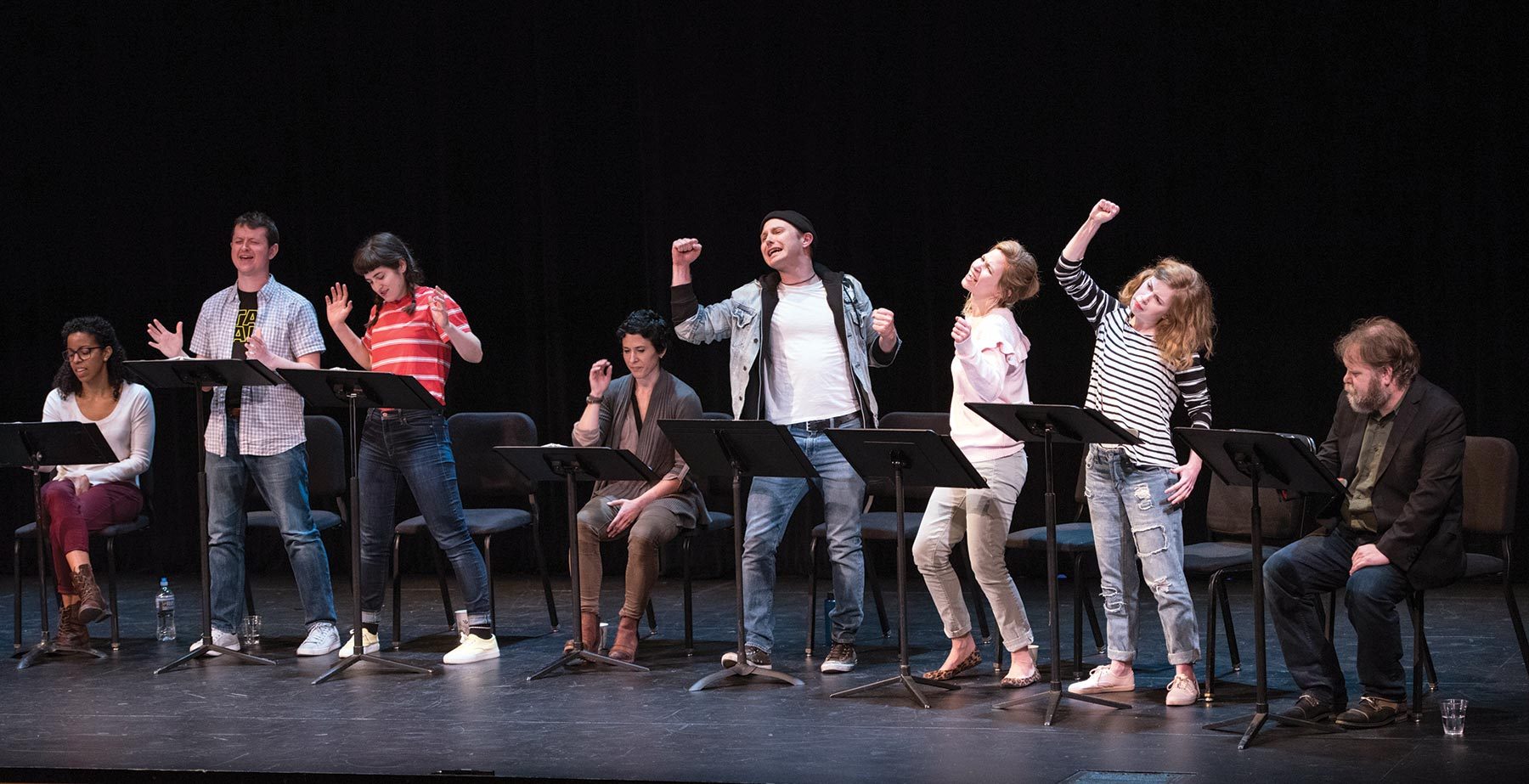
"Getting the opportunity to sit down with these people and receive their stories, their hurt, their joys, their memories – that made all the difference."
— Philip Dawkins
Ysenia Iglesias, Chris Stinson, Madeline Joey Rose, Alyssa Wilmoth Keegan, Josh Adams, Maggie Wilder, Megan Graves, and Sasha Olinick in Spamtown, USA by Philip Dawkins, New Visions/New Voices 2018. Photo by Margot Schulman.
Power and Process: Place-Based Storytelling Through the Eyes of Young People
All three pieces, despite appearing initially quite different in topic and form, highlight an important issue or challenge faced by a local geographic community: gentrification in Winston-Salem, racial divisions in Milwaukee, and labor relations in Austin. Likewise, every individual who was interviewed for this article expressed this similar importance of addressing each specific issue from the perspective of young people who experienced the real-life event. While the ideas of creating engaging young protagonists and uplifting youth voices are hardly new to the TYA field, the creative teams from all three pieces placed an extraordinary emphasis on the importance of young people’s voices in the exploration of place-based stories. TYA’s focus on highlighting the experiences and perspectives of young people is not always shared in other contexts. For instance, while much has been written about the Hormel strike that inspired Spamtown, USA, “What separates this play, I hope, from all of the many other writings about the strike is that, to my knowledge, none of the other pieces focused on the kids. No one has asked the kids, ‘What was it like growing up in this town split so violently down the middle?’” Dawkins explains. Magnasco adds that it is important to listen to young people’s opinions about the events that transpire in the places they call home, not only so they feel heard, but also because “our young people have really important things to say and incredible tools to start to heal.”
Also not a new idea in TYA or art-making in general, the creative teams from all three productions mentioned the incredible importance of specificity in creating place-based work. “Something being universal actually means that it has to be hyper-specific,” said Belflower. “Universality is actually in the details.” All three of these pieces tackle huge regional, national, and cultural challenges, but they approach them purposely through the stories of people, young people and their communities who are impacted by these issues on a daily basis. This strategy constitutes a solid approach to truly “regional” or place-based theatre for young people. And, while the initial and incredible power that all three stories deliver emerges from the theatre’s commitment to place-based stories that are performed in the place that inspired them, their stories don’t have to end there. There is little doubt that these pieces, and others like them, that delve into the questions and complexities of life in specific geographic communities, will find resonance elsewhere in the country and the world.


